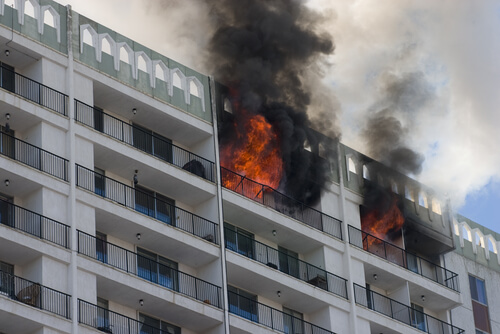There was another cladding fire in Melbourne the other day. It was one of those “accidents waiting to happen” we’ve been hearing about since the horror Grenfell Tower blaze in London two years ago.
So what actually occurred? Some flammable cladding caught alight outside a 22nd floor flat in the Neo200 building in Spencer Street and raced up five storeys on the outside of the block before it was extinguished.
Nobody died, nobody got hurt (apart from one case of smoke inhalation) residents were evacuated temporarily and, according to a news report, an Airbnb guest got a bit alarmed.
There was smoke and water damage but, critically, the fire never spread inside the building because the sprinkler system held it at bay.
So, while scary memories of the Grenfell Tower fire have been invoked, this is actually much more like the Lacrosse Tower fire, also in Melbourne almost, five years ago where, again, nobody died and no one was seriously hurt.
“The fire occurred, the sprinklers came on and, assisted by the Melbourne Fire Brigade, the fire was doused,” forensic building inspector Sahil Bhasin told ABC Radio Melbourne, adding that the building’s fire plan had worked “perfectly”.
London’s Grenfell Tower fire was a perfect storm of inadequate fire safety, poor construction, bad planning and, of course, flammable cladding. Ever since, authorities in both NSW and Victoria have been running around, looking at buildings that might have cladding and trying to identify those that are at most serious risk.
NSW has created a register of at-risk buildings, insisting that apartment block owners dob themselves in by signing up to it (did someone say “self-certification”?).
In both states, if your building is out of defects warranty (10 years in Victoria, six in NSW), apartment owners will probably have to replace the cladding at their own expense. The Neo200 is more than 10 years old.
Even if it’s still covered by statuary warranty, owners might start looking for strata defect lawyers now as they are going to be very busy over the next couple of years.
On the question of addressing flammable cladding, Victoria seems to be doing more. Their cladding task force isn’t just identifying buildings but advising them directly on how to deal with the issues.
The Melbourne Fire Brigade has created a very handy fact sheet that smart owners corporations (body corporates) anywhere would do well to distribute to all their residents.
And the Victorian government’s website has an informative guide that even tells you how to avoid buying into a block with flammable cladding. Google “MFB balconies” or “vic.gov/cladding” if you are reading this in a non-clickable format.
This is all very well, but the one lesson our governments haven’t learned from Grenfell is that they have a responsibility to apartment owners that goes beyond forcing them to fix a problem that was, arguably, caused by government neglect in the first place.
It’s a very different housing system in the UK but there the government is giving money to social housing operators to remove dangerous cladding.
In leasehold apartment blocks, possibly the closest to our system here, they are putting pressure on the buildings’ owners (read, developers) to pay for any fixes required.
Admittedly the government in Victoria has set up a schemes where apartment owners can pay for their cladding replacement through their council rates. That’s great – but it’s still apartment owners’ money that’s paying for someone else’s mistakes or deliberate corner cutting.
What more could our state governments be doing? Using their resources to chase down the people who put the crap on our buildings to begin with, organising class actions and offering help with legal fees, would be a start.
Perhaps they could threaten culpable developers that, if they leave owners in the lurch, they’ll never get to lay another brick in this country.
Oh, and they could take their fingers of the panic button for a second and try to assess the actual risk, not react to an extreme worst-case scenario that will probably never happen here.
That way they can avoid bankrupting apartment owners and turning them into victims when there isn’t even a fire … just smoke and mirrors.
A version of this story first appeared in the Australian Financial Review.




